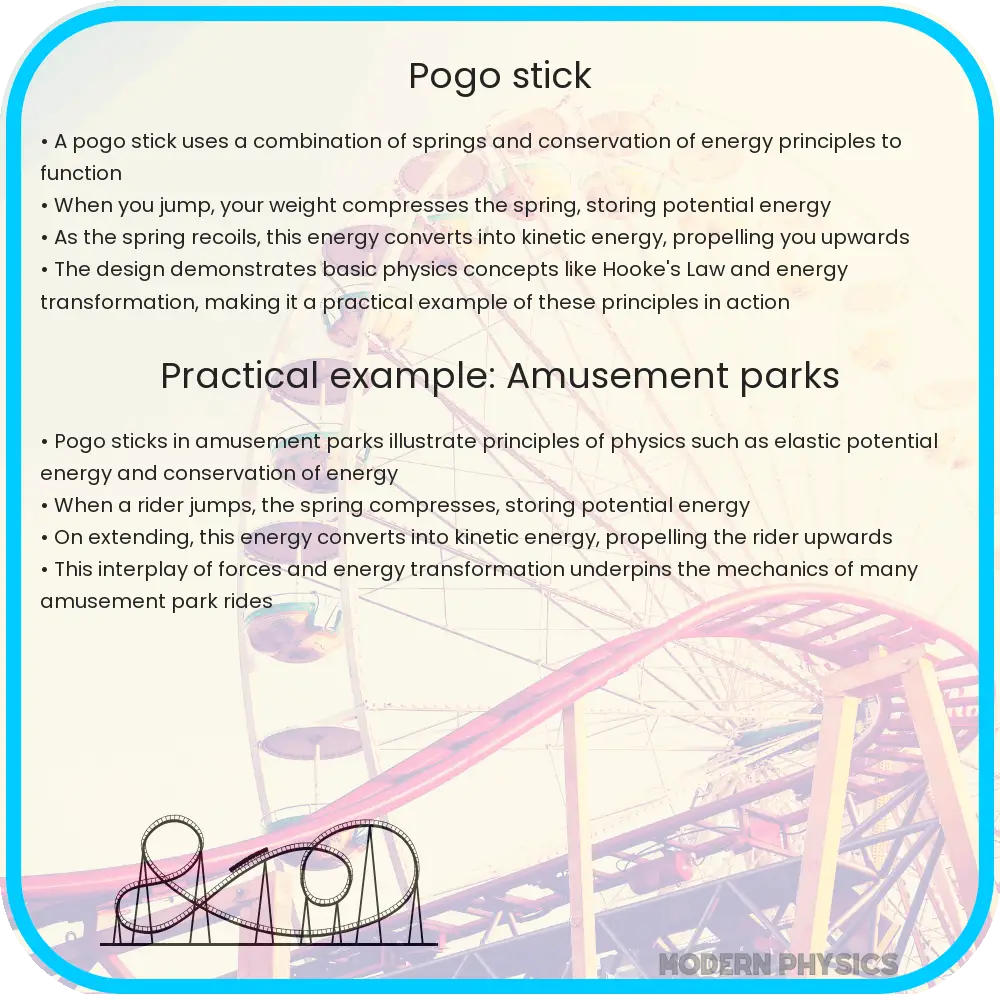Explore the physics of pogo sticks, covering motion, kinematics, energy conservation, and spring force, plus human biomechanics in jumping.

Pogo Stick Physics: Harmony, Motion & Kinematics Basics
The pogo stick, a popular toy that allows users to jump off the ground using a spring mechanism, offers a playful yet insightful demonstration of basic physics principles, particularly those pertaining to motion and kinematics. By exploring the science behind how a pogo stick works, we can gain a deeper understanding of concepts such as energy conservation, spring force, and even some aspects of human biomechanics.
The Mechanics of a Pogo Stick
A pogo stick primarily functions through the storage and release of energy. It includes several components: a handle, footrests, a pole, and a spring mechanism encased within the pole. The principles of physics that govern its motion are straightforward yet fascinating.
- Spring Force: The key component, the spring, obeys Hooke’s Law, which states that the force exerted by a spring is proportional to the displacement of the spring from its rest position, or F = -kx, where F is the force applied by the spring, k is the spring constant, and x is the displacement of the spring.
- Energy Transformation: As the rider jumps on the pogo stick, their weight compresses the spring, storing potential energy. When the spring recoils, this potential energy is converted into kinetic energy, propelling the rider upwards.
Understanding Motion through Kinematics
Kinematics, the study of motion without considering the forces that cause it, also plays a significant role in understanding how a pogo stick operates. Here, we consider aspects like displacement, velocity, and acceleration.
- Displacement: This measures the change in position of the pogo stick. When jumping, this is the distance from the lowest point of compression to the highest point the rider reaches.
- Velocity: As the spring releases its stored energy, it accelerates the pogo stick and the rider upward. Velocity is the speed of the pogo stick in a particular direction. At the top of the jump, the velocity momentarily reaches zero, marking the transition from upward to downward movement.
- Acceleration: Due to gravity, even as the spring propels the rider upward, there is a constant acceleration working in the opposite direction. On Earth, this acceleration due to gravity is approximately 9.81 m/s2, pulling the rider back towards the ground.
These kinematic equations help to predict the maximum height reached, the duration of the jump, and other dynamics of the ride. By analyzing the motion with these parameters, one can fine-tune the pogo stick performance for different riders’ weights and desired experience levels.
Human Biomechanics and Pogo Sticking
The rider’s ability to jump effectively on a pogo stick also involves an understanding of human biomechanics. Coordination and balance play crucial roles in achieving higher jumps and maintaining control. Moreover, the muscles exert forces that influence the total energy transfer to the pogo stick.
During the downward phase, riders use their legs to add force to the compression of the spring. This not only compresses the spring further than the weight alone would allow but also prepares the body for the upward acceleration. Adequate posture and positioning are critical to prevent injuries and maximize the efficiency of each jump.
Practical Tips for Pogo Stick Use
For optimal use of a pogo stick, there are several practical considerations that can enhance performance and safety:
- Adjusting the Spring Tension: Adjusting the tension of the spring according to the rider’s weight can improve performance. A tighter spring offers more resistance and higher jumps, while a looser setting is better for lighter riders or beginners.
- Safety Gear: Helmets, knee pads, and elbow pads are essential to protect against falls and injuries, especially for beginners.
- Surface Selection: Jumping on firm, flat surfaces is recommended. Uneven or soft surfaces can reduce control and increase the risk of accidents.
Physics in Play: Educational Value of Pogo Sticks
The pogo stick isn’t just a toy; it’s a dynamic tool for teaching physics. Its operation provides a tangible way to explore energy transformation, forces, and motion. By engaging with this simple device, students and enthusiasts can visualize and understand complex physical theories in a practical, enjoyable manner.
In educational settings, instructors can use pogo sticks to demonstrate the conservation of energy, the effects of gravitational acceleration, and the application of Hooke’s Law. These lessons can make the learning process interactive and memorable.
Conclusion
The pogo stick, often seen merely as a playful pastime, encapsulates various fundamental physics principles like kinematics, energy conservation, and biomechanics. By examining the mechanics of how a pogo stick works, users not only enhance their physical coordination and strength but also gain practical insights into the laws of physics that govern our everyday activities.
Whether used for recreation or as an educational tool, the pogo stick demonstrates the beauty of physics in motion, making it a remarkable instrument for both physical exercise and scientific exploration. The holistic understanding of these concepts encourages further inquiry and appreciation of the physical world, proving that sometimes, learning can indeed be fun and exciting.
